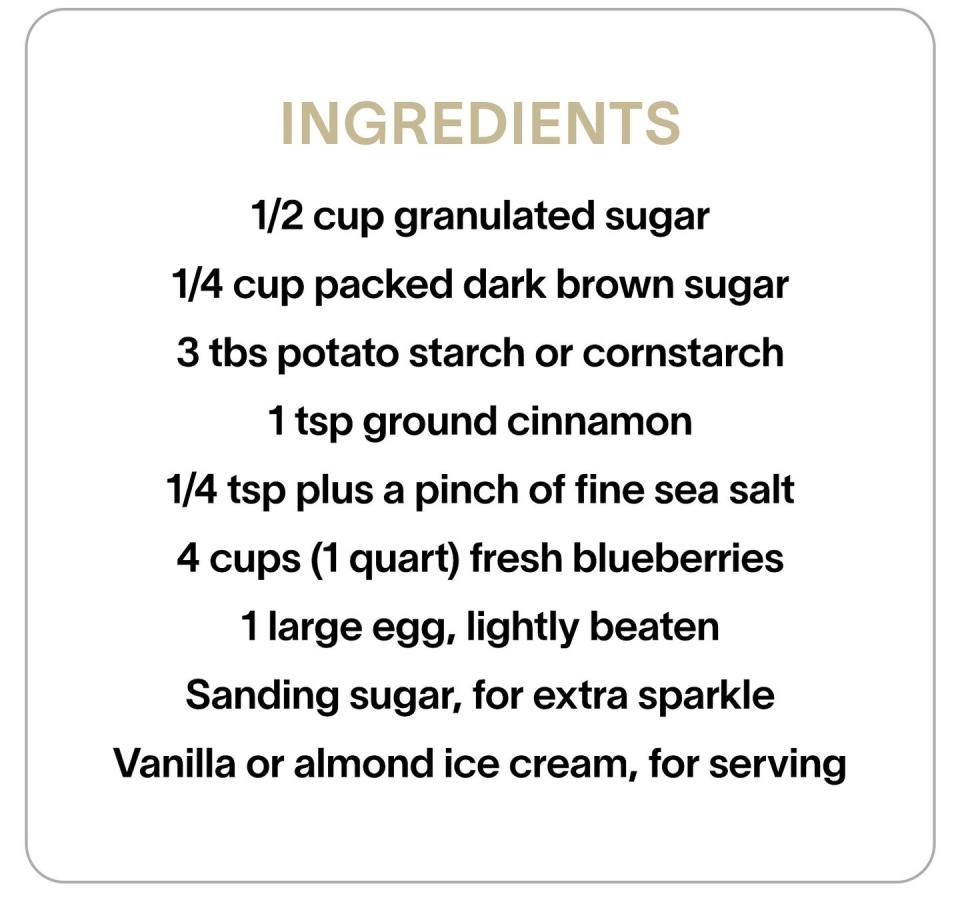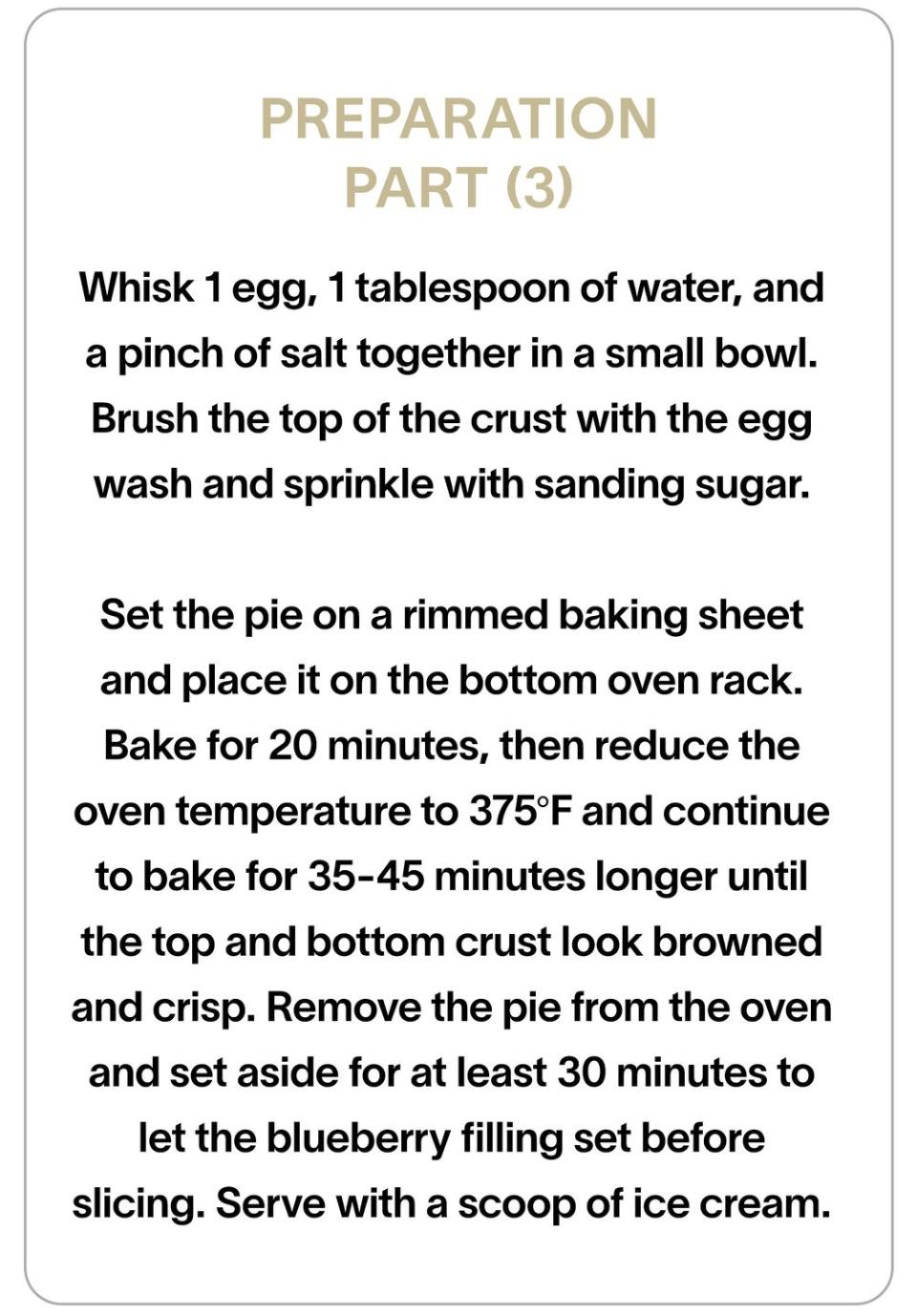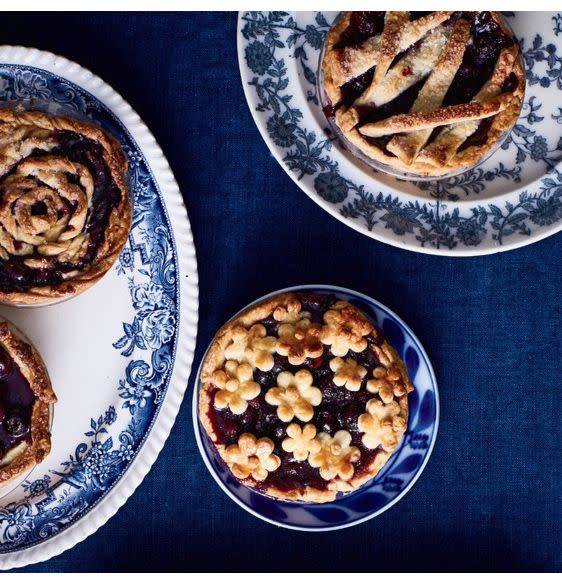My Dinner Date With Zac Posen and His Summer Blueberry Pie

- Oops!Something went wrong.Please try again later.
“Hearst Magazines and Verizon Media may earn commission or revenue on some items through the links below.”
When Zac Posen appears on my screen, he's sitting in his apartment in Paris, calmly eating snap peas. This is decidedly... not what I expected when he sent his recipe for Bucks County Blueberry Pie for me to bake ahead of our call and eat during it, blueberries spilling out of my mouth. We were supposed to be in this together—two boys chowing down on buttery crust and and compote. A three-way marriage of potato starch and brown sugar and fresh blueberries. But the famous clothier, who is in "a major crudité moment," has gone off script. He sells me on the change of heart when he spins his camera around to show off what's on his counter: plump tomatoes and green fennel that are unrealistically vibrant. "I'll tell you that the produce and food culture here is just like no other place," he says.
Zac Posen—style staple and one-time Project Runway host—doesn't seem like the most obvious person to talk to about food, but like most artists, inspiration blooms from the most unexpected soil. This is a guy who's been "inspired by everything from Jello to caviar." But beyond textiles and patterns, Posen also has a deep love of food. In 2017, he published Cooking with Zac: Recipes From Rustic to Refined after his own foray into Instagram cooking posts proved to be more popular than anyone could have anticipated. #CookingWithZac became its own version of a side hustle.
In summer of 2021, as travel restrictions relax a bit, Posen is in Paris for the first time in his adult life without the onus of sending models down runways. That means traipsing around the city, sketching designs, and eating. Eating everything in season. (Yes, tomatoes. Yes, snap peas. Absolutely no to peaches. More on that later.) But what he's offered to me today is a blueberry pie recipe that encapsulates summer like no other. We sat down over pie and, yes... peas, to discuss food, growing up in New York, and how food has intersected with his life for years on end.
This interview has been slightly condensed and edited for clarity.

Justin Kirkland: I always get really intimidated by baking, because for me, it feels like some kind of magic, like I'm going to break it. But pies are so easy.
Zac Posen: People seem to be careful with the chemistry and magic of baking. And it just takes practice and experience and jumping in, basically. I think pies in the summertime are just the best way to dive in. Good fruit, good ingredients, and time to let it sit before you serve. Scoop of ice cream, and it's perfect.

I was devastated because I'm in Brooklyn right now, and the temperature's about a thousand degrees. I finished the pies last night and realized I didn't have ice cream.
Oh no. There’s an ice cream place… what’s it called? What's the ice cream place? There's a great one in Brooklyn. Blue Marble.
So, you're in Paris. What's got you over on the continent?
I'm just here for a month or two and experiencing the city. It's the first time in my adult life that I've had time to actually take a summer and not have back-to-back collections, and it's really nice. Just exploring the city, taking inspiration, sketching, doing some work meetings.
For the past 20 years, I've really been fully in work mode here, zipping from meeting to meeting and really not getting to appreciate the city in the same way. As a teenager, my sister went to mime school, a school called l'Ecole Jacques Lecoq. And then when I went to university at Central Saint Martins in London, I spent probably like a month-and-a-half here. Then I started my company. So, after that, I was here for Fashion Week and would be in a showroom or putting on a presentation for the next 20 years. So, quite a delight. I'll tell you that the produce and food culture here is just like no other place. Then I'd say that there's a really interesting healthy eating scene that's starting that I'm seeing everywhere throughout Paris, and it's really, really well done and inventive. But it's really hard to resist the ice cream, the pastries. There's so many different specialized confectioneries and sweet shops. I'm a candy fiend.

I was going to say, what do you keep around? But I feel like anybody who truly loves candy knows that that's a disaster.
It's a disaster. What I do keep around is licorice. I like black licorice. I'm like one of those people.
Oh, that's demented.
When I'm in Europe, it's just the best, so that's what I keep.
To get to this pie, where's the recipe come from? What's the backstory on this bad boy?
Trial and error and experience and making a lot of pies. Over the years, trying every different kind of crust, different kind of flours, different ratios of butter to lard back to butter. And then I guess self-teaching and studying a lot of Japanese food. That's where the potato starch came in, instead of corn starch. I think it creates, once it cools, a really amazing texture. It's a little bit more refined than a corn starch. It's also a great ingredient for coating and light frying. I've had long conversations with my friend Daniel Humm from Eleven Madison Park about potato starch versus other starches and the properties of it.
The chemistry, I think, behind cooking is fascinating, because it's those little touches that can completely change a dish or make it something that you didn't even imagine it could be.
Yeah. I mean, for me, the history of produce is kind of like the history of humanity and science, all of it, in one. The history of fashion and textiles are as well. So, in some kind of way, it's like being a sensory anthropologist.
I feel there has to be so much crossover between fashion and cooking that probably doesn't make sense to a lot of people who aren't in the throes of both.
Totally. Well, first of all, to me the greatest, most generous gift you can do is to cook for somebody, and a pie is pretty high up there on the list. And it's really such a generous, humble offering. And I think in fashion… fashion really starts with the imagination, and then the material and process and technique. Putting it together in this way, it starts with preparation. And they're very similar. You're working with the material and then having an experience with it, one you're eating and one you're wearing. But it's about how it makes you feel—the texture, the feeling, the flavor. They're very, very similar processes for me. I think fashion takes a little bit more preparation in terms of actually the time in making it, but not always the case.
Do you have any ingredients where it's like, "I'm a purist on this. I'm sorry, I just can't bend?"
I'm almost at the stage where I will hold off on eating tomatoes until real tomato season. My parents live on a farm in Pennsylvania in Bucks County. And homegrown? Just there's nothing better. That smell. I love the smell of tomato leaves and the vine. I don't know how to describe what that scent is. An almost kind of citronella-y. I don't know. It's that weird green smell next to a really sweet, ripe tomato or little cherry tomato, makes me crazy. Really good radishes I'll wait for. Listen, you can get great produce almost all year round now, but it's just different when it's in season. Peaches, I wait. Peaches and nectarines and apricots. I don't think I ate a peach since last summer.

How did you cope with cooking through the pandemic? I feel like even the people who love to cook most had to get burned out.
Last summer I was in Long Island, and I cooked... I had a friend and she put me on daily pies, and it got even to the point where it was intense. Every lunch I was making a pie, where I just had to stop at a certain point. It was like, too much. I can't. Pie, pie, pie, pie, pie. We're going to get quirky quickly eating pie at every meal.
But I also got really healthy over the pandemic. I know some people went real decadent. I took it as an opportunity to really have the time to cook, and take my time, and prepare. I was lucky that cooking, for me, was either for friends that were in my pod or people I was with, versus the pressure for people who are not used to cooking of having to cook for their family breakfast, lunch, and dinner. I think it was really shocking. A great deal of my day was spent answering questions from friends day to night—food and garden questions. It was really funny. It was like a direct message machine.
Someone told me recently that coming through the pandemic, so many New Yorkers were thrown because they just don’t cook. It’s an order-out town. What was it like for you growing up in the city with a family that cooked? Were you guys big cooks in the kitchen?
Yeah, my dad cooked every night.
Really?
Yeah, he cooked every night. He's a painter, and half of our loft in SoHo that he grew up in was his studio, then the other half was our living space. Both my parents are of that generation that was a food revolution generation, and they learned together. They avidly followed the New York Times cooking section, saved clippings, and collected cookbooks. And growing up downtown, our shopping was in Little Italy and then Chinatown. So, that exposed me to a lot of different kinds of ingredients that I don't think had been so homogenized or available to so many people as they are now. I grew up eating seaweed and noodles and tofu as a kid, and that was like my snack food.
Then to juxtapose it, I had a Norwegian babysitter. So, I had Norwegian food influence in my life. Definitely salty licorice comes from there, and all kinds of marzipan pigs and different kind of pickled fish. And growing up in New York, Chinese takeout was really big in the '80s. That was like a special night. And then for family celebrations, there was a Japanese restaurant on University Place called Japonica, and that was my introduction to Japanese food and the culture, which I just fell in love with from an early age.

I think one of the most fascinating conversations that's come up in the past year or two is finding a way to not only celebrate international food but also make sure that we're honoring the heritage of where it comes from. Not just the dishes, but the ingredients that are sourced from all these places. What are your thoughts about that conversation?
Well, I think if it's available, go for it. I also think today if you're able to grow your own produce, go for it, and order seeds from those countries. I think that food, as I said, is part of history, so it evolves through the course of history. So, through trade and movement of tribes and climates and evolution, ingredients have changed and morphed and... I don't know. Just even pasta and its transition from China to Italy to globally. I think that food is to be shared and loved and interpreted.
It's almost like our stories are, no pun intended, baked into the food.
Yeah.
When it comes to cooking and design, has there ever been something that you've made that's ended up influencing a design of yours? Or vice versa: You've made something and you're like, "God, I've been looking at this red velvet all day. All I want is a good marinara."
Oh, for sure. Food and ingredients are so beautiful. So, I'm constantly inspired by nature. Immediately, vegetables or fruits and how they grow and their construction has definitely been informative for me. And definitely I've been inspired by everything from Jello to caviar and beading. And tactile, or taste and tactile stuff, for sure. I mean, working with velvet and having a great mousse is such a direct correlation for me.

Has there ever been a time where you've been in the real throes of Fashion Week or putting together this cookbook where you're like, this feels more like a job than it is a passion?
Absolutely. I mean, I took the process really seriously doing the book, and it can be quite tedious at times. When you're doing a testing or something's not working out and it's like the fourth time you've cooked it, you have that moment where you're like, back to the store to buy the same ingredients and testing that, and where you just can't even... you don't even want to try it.
The question that we always end on with this series—why this recipe? Why a blueberry pie?
Because there's just nothing better. It's summertime. It's a summertime celebration. And, I mean, who doesn't love a blueberry pie? It's something that's really personal. It's also one of my favorite images in my cookbook. And I think it's a really perfected recipe, and I think there's a few tricks in it in how we put it together that are really helpful. I think what you brush it with, the ratio, the potato starch versus a corn starch, help perfect such a classic.
For unlimited access to celebrity recipes—and celebrities nerding out about these recipes—join Esquire Select.
You Might Also Like

